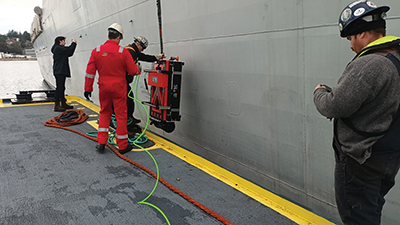TSC Subsea’s ART achieves Lloyd’s Register validation for quantitative ship hull thickness measurement
13/12/2024
TSC Subsea has announced that its proprietary non-destructive testing (NDT) technology, acoustic resonance technology (ART), has received validation from Lloyd’s Register for performing quantitative ultrasonic thickness measurement (UTM) on ship hull carbon steel plates through coatings, assessing both internal and external corrosion defects.
This validation represents a significant advancement in NDT technology for the maritime industry, establishing new standards for efficient and quantitative corrosion detection on hull structures above and below the waterline while the vessel is at sea in service.
The validation was awarded following extensive testing on a Hull Inspection Techniques and Strategy (HITS)
Joint Industry Project (JIP) test plate, representative of a single-skin floating production, storage and offloading (FPSO) hull. In these trials, TSC Subsea’s ART scans were benchmarked against phased array ultrasonic testing (PAUT), a widely recognised and approved NDT technique.
 | ||
| ART is setting new standards for corrosion detection in the maritime industry |
ART demonstrated outstanding effectiveness in detecting and quantifying hidden defects through protective coatings on the ship hull test sample, underscoring its reliability and efficiency as an inspection technique.
Unlike traditional methods, ART is a non-contact inspection technology, making it highly tolerant of challenging surface conditions and marine growth. This capability enables accurate corrosion mapping, even on surfaces that are difficult for other technologies.
ART allows inspections to be conducted while the vessel is in service, minimising downtime and enhancing operational efficiency. This feature offers a significant advantage for the maritime industry, where interruptions and dry-docking can incur substantial costs.
ART detects and maps corrosion on both external and internal surfaces of hull structures, providing a complete view of asset integrity without requiring the removal of protective coatings.
While both ART and PAUT use ultrasound technology, ART operates at lower frequencies and offers a broader bandwidth, enabling it to penetrate coatings that PAUT cannot, expanding its applicability across various conditions.
With this recent validation from Lloyd’s Register, TSC Subsea’s ART technology sets a new standard for corrosion detection in the maritime industry. ART’s unique capabilities not only improve efficiency but also deliver accuracy and reliability comparable to PAUT, all while preserving protective coatings.